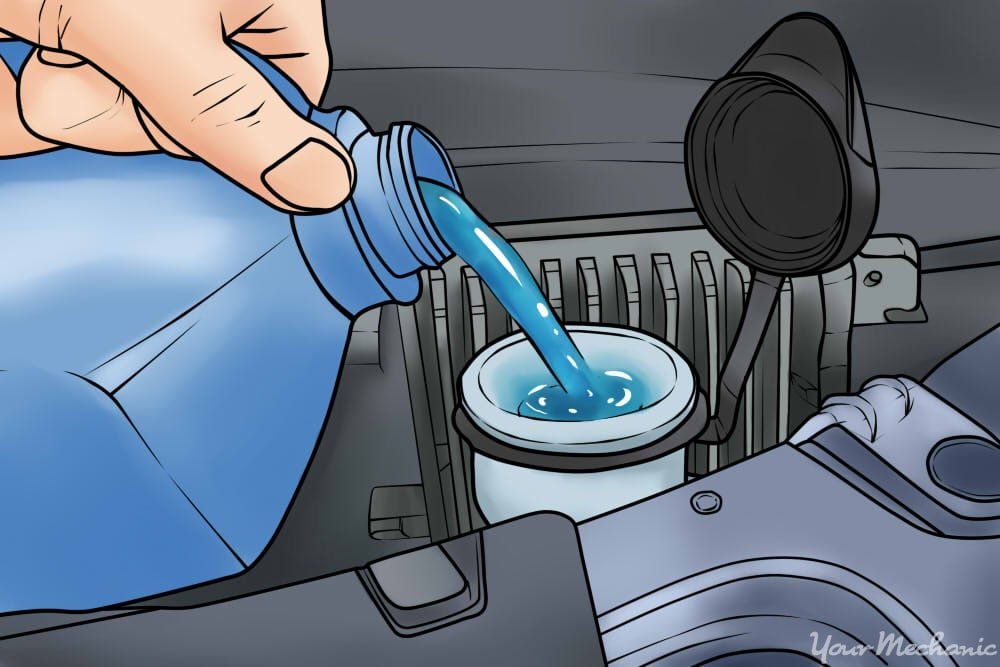
Efficient Guide On How To Fill Washer Fluid
To fill washer fluid, locate the reservoir under your car’s hood. Check the fluid level to ensure it’s low, then unscrew the cap. Pour washer fluid in until the reservoir is full. Replace the cap securely. Properly filled washer fluid is crucial for clear visibility on the road. Follow these simple steps to maintain a safe driving experience.
How to Fill Washer Fluid: A Step-by-Step Guide
Welcome, curious minds! Today, we’re diving into the world of car maintenance to unravel the mystery of how to fill washer fluid. Whether you’re a budding car enthusiast or a responsible driver looking to keep your vehicle in tip-top shape, mastering the art of filling washer fluid is a crucial skill to have. So, buckle up and get ready to learn the ropes!
What is Washer Fluid and Why is it Important?
Before we get our hands dirty, let’s talk about what washer fluid actually is. Washer fluid, also known as windshield wiper fluid, is a specially formulated liquid that helps clean your windshield while driving. It’s essential for maintaining clear visibility on the road, especially in challenging weather conditions like rain or snow.
Think of washer fluid as your trusty sidekick, always ready to spring into action and wipe away dirt, grime, and pesky bugs that obstruct your view. Without enough washer fluid in your reservoir, your windshield wipers won’t be able to do their job effectively, putting you at risk of reduced visibility and potential hazards.
Checking Your Washer Fluid Levels
Before we jump straight into the filling process, it’s essential to check your current washer fluid levels. You don’t want to end up pouring in more fluid only to realize that your reservoir is already full. Here’s how you can check your washer fluid levels:
Step 1: Locate the Washer Fluid Reservoir
The washer fluid reservoir is usually a translucent plastic container located near the windshield of your car. It’s often marked with a symbol that looks like water squirting onto a windshield. Pop open the hood of your car and look for the reservoir.
Step 2: Check the Fluid Level
Once you’ve located the reservoir, look at the side to see how much fluid is left. There should be markers indicating the minimum and maximum levels. If the fluid level is below the minimum mark, it’s time to top it up.
Filling Your Washer Fluid
Now that you’ve confirmed that your washer fluid levels are low, it’s time to roll up your sleeves and get to work. Here’s a step-by-step guide on how to fill your washer fluid:
Step 1: Choose the Right Washer Fluid
Not all washer fluids are created equal. Some are designed for specific weather conditions, such as winter-grade fluid for colder climates. Make sure to choose a washer fluid that suits your needs and the prevailing weather conditions in your area.
Step 2: Open the Reservoir Cap
Locate the cap of the washer fluid reservoir and twist it counterclockwise to open it. Be gentle to avoid damaging the cap or the reservoir.
Step 3: Pour in the Washer Fluid
Take your chosen washer fluid and carefully pour it into the reservoir. Be mindful not to spill any fluid outside the reservoir, as it can be harmful to your car’s paintwork. Fill the reservoir up to the maximum level indicated on the side.
Step 4: Secure the Cap and Test Your Wipers
Once you’ve filled the reservoir, screw the cap back on tightly to prevent any leaks. Close the hood of your car and hop inside to test your windshield wipers. Activate the washer fluid function to see if the fluid sprays correctly onto your windshield.
Maintaining Your Washer Fluid Levels
Now that you’ve successfully filled your washer fluid, it’s crucial to keep an eye on your levels regularly. Make it a habit to check your washer fluid levels every few weeks, especially before embarking on long journeys or during the changing seasons.
Remember, a little care can go a long way in ensuring your safety and the longevity of your car’s components. So, give your car the love it deserves by keeping its washer fluid topped up and ready for action!
Congratulations, intrepid learners! You’ve now mastered the art of filling washer fluid like a pro. With this newfound knowledge, you can tackle this essential car maintenance task with confidence and ease. Remember to check your washer fluid levels regularly, choose the right fluid for your needs, and keep your windshield sparkling clean.
Safe travels and happy driving!
How to top up your windscreen washer fluid @carsales.com.au
Frequently Asked Questions
How do I check the washer fluid level in my vehicle?
To check the washer fluid level in your vehicle, locate the washer fluid reservoir typically labeled with a windshield symbol under the hood. The reservoir is transparent or has markings indicating the fluid level. Make sure the engine is off and cool before checking.
What type of washer fluid should I use for my vehicle?
It is recommended to use a windshield washer fluid specifically designed for vehicles. Choose a fluid that provides good visibility and is rated for the appropriate season (e.g., winter formula for colder temperatures). Avoid using water or other substitutes as they may harm the system.
How do I refill the washer fluid in my car?
To refill the washer fluid, open the cap of the washer fluid reservoir and pour the washer fluid carefully using a funnel to avoid spills. Fill it up to the indicated level or just below the rim. Avoid overfilling to prevent leaks when driving.
When is the best time to fill washer fluid in my vehicle?
It is advisable to top up the washer fluid whenever you notice it running low or before a long trip to ensure you have a clear windshield. Regularly checking and maintaining the washer fluid level helps in maintaining visibility, especially during adverse weather conditions.
Final Thoughts
Remember, keeping your washer fluid topped up is essential for safe driving. To fill washer fluid, locate the reservoir and remove the cap. Slowly pour the fluid in until it reaches the fill line. Finally, securely close the cap to prevent leaks. Stay safe on the road by regularly checking and refilling your washer fluid.


